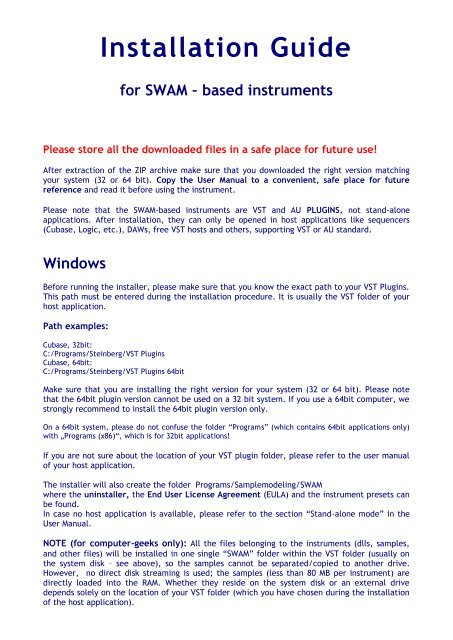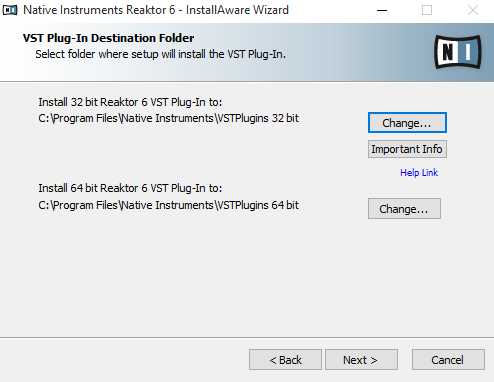How To Install Vst Plugins Cubase
How to install VST plug-ins. As well for effects as for VST-is, on the PC platform, we will distinguish two different technologies. On one hand, there are VST plug-ins which use Steinberg's protocol. These plug-ins can be used in any VST compatible applicatin, and there are many of them! Steinberg Cubase Selecting VST Presets - Importing, Browsing, Exporting FXB Banks and FXP Presets (VST2 Plugins) Selecting VST presets. VST Instruments come with a large number of VST presets for instant selection. Presets can either be accessed from the. Go to my computer, click on C: drive and navigate to that folder and see if it’s there, if not then see if there’s a VST Plugins folder in C:Program Files. These are the two standard places to look. Tip: If you have two hard drives or partitions it’s an idea to create a folder here and add it to your DAWs vst folder list. —-Install. In Cubase you simply load Melody Sauce as a VST plugin onto its own MIDI track, and then route the outgoing MIDI from this track to any software instrument track. Choose your key, mood and complexity options and speed settings to generate customised melodies to fit your project and you’re ready to create, audition and select melodies instantly. Rock Pro is a free program that enables you to configure the Rock Pro guitar. Start Cubase, open the Studio menu and select the entry VST Plug-in Manager. In the lower left corner of the VST Plug-in Manager window, open the Plug-in Manager Settings by clicking the cogwheel icon. In the Plug-in Manager Settings window, click on the Add Path button.
- How To Install Vst Plugins Cubase 10
- How To Install Vst Plugins Cubase Presets
- Cubase Vst Folder
- Free Vst Plugins For Cubase
Follow the steps below to add your NI VST folder to Cubase 9 (and higher): Start Cubase, open the Studio menu and select the entry VST Plug-in Manager. In the lower left corner of the VST Plug-in Manager window, open the Plug-in Manager Settings by clicking the cogwheel icon. In the Plug-in Manager Settings window, click on the + button.
After I upgraded to Cubase 9 and went “totally 64bit” I had a problem with my DAW not finding the 54 Waves plugins. I also had the same problem with Maschine and Waves.
A quick search on the forums showed that this is a common issue but there is lots of disagreement about how to actually fix it.
The problem occurs because both 32bit and 64bit Waves plugins all sit in the same folder within Program Files (x86) – a location normally used for 32bit stuff!
Try as you may by pointing your DAW to the right location, both Cubase and Maschine were not having it!
I tried lots suggestions before finally discovering a post on the Steinberg Forums by user KurtOzzthat did the trick – actually instructions from Waves support:
Uninstall All Products via Waves Central:
In Waves Central go to Install->Uninstall Products (at the top).
Choose all the products click ‘Uninstall’.
Once uninstall is finished – quit Waves Central.
Uninstall Waves Central :
Uninstall Waves Central itself using Control Panel->Programs and Features
Remove Various files:
Click on Winkey+R and enter the text %appdata% – click Enter. Delete the Waves folder inside ‘Roaming’.
Click on Winkey+R and enter the text %programdata% – click Enter. Delete the ‘Waves Audio’ folder.
Conduct a file search on your system for the term :”WaveShell” and delete any “WaveShell” file that you find.
Re-Install:
Download and install the latest Waves Central for Windows
Run Waves Central application and log-in.
Click on Install at the top tab, then select Install
Click Online (on left pane)
Select all your products (in the middle pane)
Click Install on (the bottom right)
Many thanks to Kurt – that really did the trick for me, hopefully it will help others too.
Related
This site uses Akismet to reduce spam. Learn how your comment data is processed.

1. The Initial Scan
VST plug-ins in Reason have the same priviliges as any other rack module or Rack Extension, so they can be used in exactly the same way. However there are a few extra things to know about. When you first launch Reason 9.5 it will scan your VST folders. In case you have any custom VST folders set up, you can go into the Preferences > Advanced tab and under the folder location section, add any custom folders. If you are only using your system’s default locations on Mac or PC, they should be set up automatically.
2. Manage Your VSTs
Reason should warn about any incompatible plug-ins during the scan. Go to the Window > Manage Plugins option and you will see a list of available plugs. You can select any one to manually disable it, although it’s unlikley you would need to do this. If any plugs have been disabled by the scan you can choose them and press Enable to make Reason look at them again. If a plug has been disabled it probably means it needs an update, so try this via the plug-in’s own product website.
3. Load A VST
With those initial steps out of the way, you’re ready to roll. The Browser now has extra sections under the Instruments and Effects tab so while you’ll see Propellerheads’ own modules at the top, if you scroll down either list you will see your VSTs grouped by manufacturer, and of course you can simply type in a search for the name of any plug that you want, or add them to a favourites list for quick access. Double click on any VST or drag and drop it to load just like you would any regular module.
4. Add A Screenshot
One fun thing you can do is add a manual screenshot of a plug. Since Reason can’t guess what every VST will look like, you can click on the black area of the VST rack module to open the instrument or effect’s own interface, just like it appears in any other DAW. This associates a thumbnail with the plug’s Browser entry, and it will stay there. This means you can now identify a VST by sight. If you want to replace the screen shot of any VST, just click the Screen Shot button on its window again to replace with the current view.
5. Assign CV To VSTs
While VST instruments and effects can be patched, routed and played by MIDI just like any module in Reason, the VST rack module has a few new tricks up its sleeve. If you go to the CV programmer section and expand it, you can click on the Parameter column for any of the 8 slots and see all assignable parameters for that instrument. Each one will have a different set of controls that you can send CV to. This section also has Learn, Base Value and Clear buttons for each slot, so you can make custom configurations easily. The idea here is to take CV signal from elsewhere – other modules or generators – and send it to modulate VST parameters. Previously this would have required lots of workarounds and involved ReWire.
6. A CV Example
One use for this might be to take one of Reason’s trigger modules like an arpeggiator and hook up some of its CV outs to the CV ins of the VST module using the rear panel. CV assignment works the same way it always did in Reason, only now you can easily patch that CV signal into your favourite VST instruments.
7. Using VST Effects
Using VST effects in the rack works the same way – drag and drop an effect wherever you want it to go. The CV assignment from the front panel also works the same as with instruments. And around the back, the VST rack module has identical ins and outs. Although there are 8 additional audio inputs and 16 audio outs, these will only light up in green (meaning they can be used) when the VST supports them. So for example some plugs will just work in stereo, but others will have up to 16 or more outputs. You can see how many by looking in this area.
8. Multi-Output Plug-ins
In an example where a plug supports multiple outputs, Reason won’t manually create mixer channels for every output as this could quickly cause the mixer to become overcrowded. If you want to use more than two outputs, right click on the multi-output instrument or effect (here it's Kontakt) and choose Create Mixer Channel for as many stereo channels as you want. Then name them and route the relevant outs from Kontakt to them. Free toy vst. It’s quick and easy, and this screenshot shows you how to set it up.
How To Install Vst Plugins Cubase 10
9. Connect VSTs To Remote
In cases where a VST uses the .fxb / .fxp preset format, presets will be accessible using the regular patch browser button on the VST rack module. Many do not use this format however so you will need to open their GUI in order to select a preset. Alchemy vst mac free. The Props have made other Reason features available to VSTs. For example if you click on the Remote button on a VST’s window header, you can assign any physical MIDI control to a parameter inside the VST just like you can with Reason’s own modules. This means no tedious mucking about with MIDI maps.
10. Automate Any VST

How To Install Vst Plugins Cubase Presets
Another button on the title bar is Automate. For devices that don’t yet have a sequencer track like effects, you must remember to right click on the device in the rack and click Create Track For… so it can record automation information. With record enabled and while playing back, hit the Automate button and move a parameter, and data will be recorded in the new sequencer track.
11. Export Your Stems
Cubase Vst Folder
Finally, VST channels appear just like regular channels when it comes time to export stems, so you can esily export instrument or effect channels for mixing elsewhere.